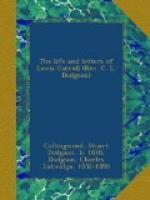Appendix II. is headed by the somewhat startling question, “Is Euclid’s Axiom true?” and though true for finite magnitudes—the sense in which, no doubt, Euclid meant it to be taken—it is shown to be not universally true. In Appendix III. he propounds the question, “How should Parallels be defined?”
Appendix IV., which deals with the theory of Parallels as it stands to-day, concludes with the following words:—
I am inclined to believe that if ever Euclid I. 32 is proved without a new Axiom, it will be by some new and ampler definition of the Right Line—some definition which shall connote that mysterious property, which it must somehow possess, which causes Euclid I. 32 to be true. Try that track, my gentle reader! It is not much trodden as yet. And may success attend your search!
In the Introduction, which, as is frequently the case, ought to be read last in order to be appreciated properly, he relates his experiences with two of those “misguided visionaries,” the circle-squarers. One of them had selected 3.2 as the value for “pi,” and the other proved, to his own satisfaction at least, that it is correctly represented by 3! The Rev. Watson Hagger, to whose kindness, as I have already stated in my Preface, my readers are indebted for the several accounts of Mr. Dodgson’s books on mathematics which appear in this Memoir, had a similar experience with one of these “cranks.” This circle-squarer selected 3.125 as the value for “pi,” and Mr. Hagger, who was fired with Mr. Dodgson’s ambition to convince his correspondent of his error, failed as signally as Mr. Dodgson did.
The following letter is interesting as showing that, strict Conservative though he was, he was not in religious matters narrow-minded; he held his own opinions strongly, but he would never condemn those of other people. He saw “good in everything,” and there was but little exaggeration, be it said in all reverence, in the phrase which an old friend of his used in speaking of him to me: “Mr. Dodgson was as broad—as broad as Christ.”
Christ Church, Oxford, May 4, 1889.
Dear Miss Manners,—I hope to have a new book out very soon, and had entered your name on the list of friends to whom copies are to go; but, on second thoughts, perhaps you might prefer that I should send it to your little sister (?) (niece) Rachel, whom you mentioned in one of your letters. It is to be called “The Nursery Alice,” and is meant for very young children, consisting of coloured enlargements of twenty of the pictures in “Alice,” with explanations such as one would give in showing them to a little child.
I was much interested by your letter, telling me you belong to the Society of Friends. Please do not think of me as one to whom a “difference of creed” is a bar to friendship. My sense of brother- and sisterhood is at least broad enough to include Christians of all denominations; in fact, I have one valued friend (a lady who seems to live to do good kind things) who is a Unitarian.
Shall I put “Rachel Manners” in the book?




